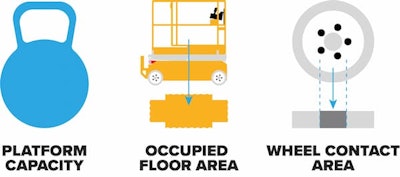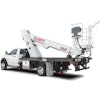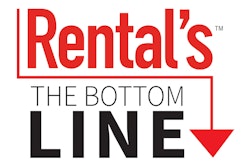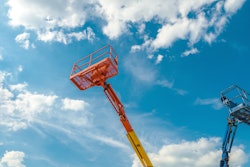
This blog was adapted and edited from its original version, "What is Floor Load & How Do Scissor Lift Brands Stack Up?" on the Hy-Brid Lifts website with permission from the company.
The increased demand for efficiency from contractors and jobsite planners, as well as the spread of sensitive flooring materials like computer flooring, has brought floor load into the spotlight. Many construction sites now call for machines that produce less strain and prevent damage to the floor or building structure. But what exactly is floor load?
What is Floor Load?
Floor load, or ground pressure, is the amount of force a floor can withstand or the amount of pressure a machine exerts. If the pressure exerted by a scissor lift or any other piece of equipment exceeds the capacity of the floor beneath it, damage can be done to the floor or to the building’s structure.
Naturally, when we think of pressure, our first thought goes to the weight of the machine, but this is not the only factor at play. Platform capacity, gross machine area, occupied floor area, and wheel contact area must also be considered to get an accurate idea of how much strain the machine is exerting.
Let’s run through those terms quickly:
Platform capacity: The amount of external weight added onto the platform.
Gross machine weight: The total weight of the machine plus the weight of anything on the platform. The minimum value would be the same as the machine weight if it is empty. The maximum value would be the weight of the machine plus the platform capacity.
Occupied floor area: The estimated floor space occupied by the machine base. Calculating this value is simply the length of the chassis multiplied by the width of the chassis.
Wheel contact area: The area that the lift’s wheels are in contact with the floor. Remember to multiply the value of an individual tire times four to get the value for all four wheels.
Maximum Machine Load vs. Maximum Wheel Load
When determining whether a lift is safe to drive on a specific surface, you must consider both the machine load and the wheel load. These measurements are similar but vary in what parts of the structure they will impact.
Maximum machine load is the upper limit to how much weight a surface can support. If this value is exceeded, it can damage the building’s structure, such as beams and concrete, as the floor will not be able to support the weight of the machine. Machine load is measured in pounds per square foot or PSF.
Check out the latest podcast with Hy-Brid Lifts for more safety tips.
Maximum wheel load focuses on the individual wheels rather than the whole machine. When lift platforms are loaded, the added weight does not distribute equally, causing the four tires to each exert a different amount of pressure on the floor. So, while the machine’s total weight may be lower than the floor’s requirements, depending on how the platform weight is distributed, the lift may still exceed the maximum wheel load.
If this were to occur, the pressure could cause cracks or punctures to the floor’s surface. This is especially important on more sensitive materials like tiles, carpet, or wood. While the force being quantified is the same, wheel load is measured in pounds per square inch or PSI.
Calculating Machine Load
We’ve run through all of the important terms and concepts to calculate machine load, so now we can put them all together and do the math. Machine load is determined by taking the gross machine weight divided by the occupied floor area. An expanded formula would look like this:
(Machine weight + occupied platform capacity) / (chassis length * chassis width)
As lean construction and sensitive flooring continue to become more prevalent on construction sites, floor load becomes more important than ever.



















